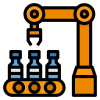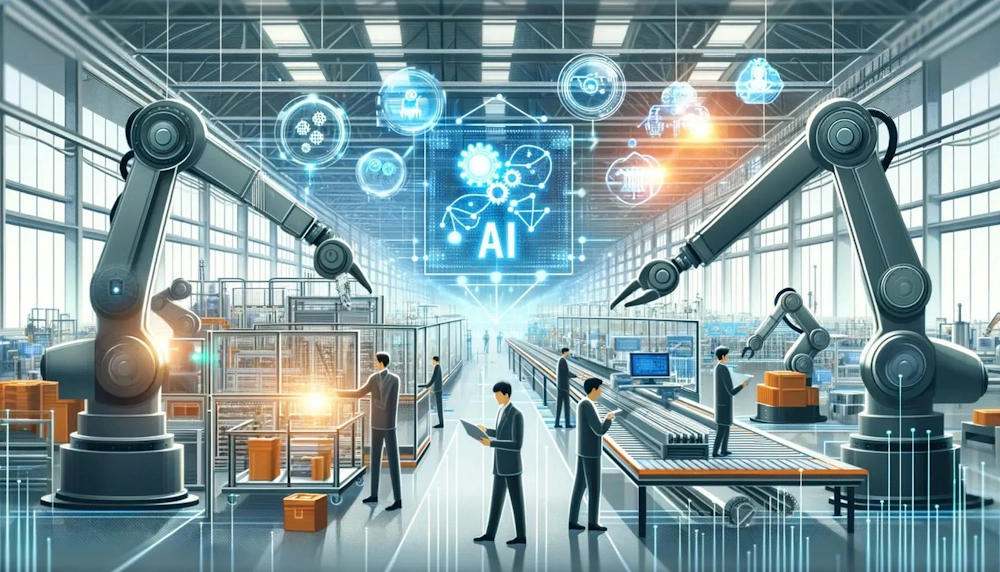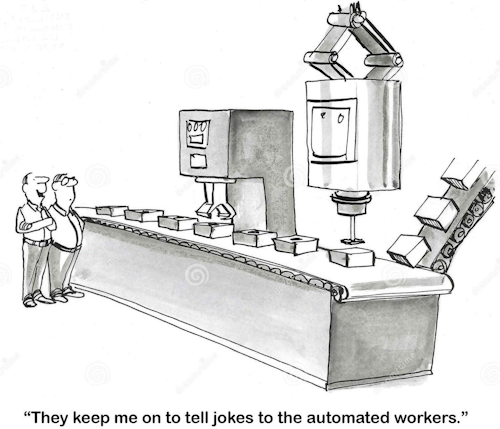 AI in Manufacturing
AI in Manufacturing
Machine learning and deep learning algorithms can analyze large datasets for patterns
Related: AI Industry | AI Companies | AI Stocks
AI can then act on that data to complete tasks, automate processes, or provide insights that manufacturers can use to benefit their business. While AI can be used in many ways, some of the most common applications in manufacturing include factory automation, including scheduling and resource management, intelligent operations and management, quality and process monitoring, supply chain optimization, and data-driven decision-making.

AI-powered robots can be used to handle dirty, repetitive, or dangerous tasks to improve human safety and productivity. AI-enabled video systems can monitor production environments for potentially hazardous conditions or to identify unauthorized access to restricted areas to prevent potential mishaps. AI-based systems can monitor energy and materials usage and provide system or workflow adjustments to help reduce waste and improve energy efficiency, which also contributes to sustainability initiatives.
 Benefits of AI in Manufacturing
Benefits of AI in Manufacturing
- Improved safety, efficiency, and performance
- Optimize production processes to increase throughput
- Monitor equipment to ensure optimal operation
- Predict maintenance needs to maximize uptime
- Automate repetitive or hazardous tasks

Uses of AI in Manufacturing
- Automated robots: Industrial robots have been a staple in the manufacturing industry for a while. However, integrating AI into automated robots represents a significant advancement in manufacturing technology. Unlike traditional industrial robots programmed with fixed instructions, AI-powered robots can learn from their environment, adapt to changing conditions, and make decisions autonomously. AI robots, unlike human workers, can operate continuously without the need for breaks. They also demonstrate significantly lower error rates, a feature that allows manufacturers to scale their production capacity with confidence.
- Collaborative robots: Collaborative robots, also called cobots or co-robots, are robots that work alongside workers in a factory to complete a task that can't be fully automated (and performed by an automated robot). This collaborative approach to automation improves efficiency, flexibility, and ergonomics in manufacturing operations while allowing workers to focus on more complex tasks that require human intelligence.
- Demand forecasting: AI is increasingly implemented in demand forecasting to improve accuracy and reliability. AI algorithms can identify patterns and trends that you may overlook by analyzing large volumes of data, including sales data, customer behavior, economic indicators, and external factors (e.g., weather patterns).
- Digital Twins: A digital twin is a virtual replica of a physical asset that captures real-time data and simulates its behavior in a virtual environment. By connecting the digital twin with sensor data from the equipment, AI for the manufacturing industry can analyze patterns, identify anomalies, and predict potential failures. This information gives maintenance teams predictive insights to schedule maintenance interventions proactively before equipment failure occurs.
- Generative AI: Generative AI can generate synthetic data that simulates potential failure scenarios. This synthetic data can then be used to train predictive maintenance models.
- Intelligent Automation: Intelligent automation is the combination of intelligent software and robotic equipment. It uses AI's advantages to automate tasks that go beyond repetition by combining AI, industrial robots, or robotic process automation.
- Managing inventory: AI systems enable manufacturers to maintain optimal inventory levels considering multiple factors like lead time, holding costs, ordering costs, and service level requirements. Thanks to real-time tracking of stock levels, order status, and anticipated delivery times, manufacturers can balance the stock inventory and enhance inventory visibility across the entire supply chain. This enables manufacturers to anticipate changes in demand more accurately, optimize inventory levels, and make informed decisions about production, procurement, and resource allocation.
- Predictive Maintenance: Predictive maintenance is undoubtedly one of AI's most trending and game-changing use cases. It's no wonder, considering AI-based predictive maintenance can significantly improve the manufacturing process. By analyzing data collected from sensors, equipment telemetry, and other sources, the machine learning algorithms can forecast when equipment failures are likely to occur. This AI solution allows manufacturers to schedule maintenance proactively, minimizing downtime and reducing maintenance costs.
- Quality Control: A mistake during production jeopardizes the final product's quality and safety. AI-powered computer vision systems can mitigate these risks by analyzing images or sensor data to detect defects or anomalies in products. Machine learning algorithms are trained on labeled datasets to recognize patterns associated with defects, allowing for automated defect classification and sorting.
- Robotic Process Automation: Robotic Process Automation (RPA) automates repetitive, rule-based tasks that workers typically perform on computers. It uses software bots to mimic human actions like data entry, copying files, and filling out forms. Invoices, orders, reports, checklists; paperwork is in every aspect of manufacturing. If digitizing paperwork is the first step towards efficiency, bringing in an AI-based RPA is the ultimate goal. RPA is an assistant that takes care of repetitive paperwork tasks. Using AI, it can bring decision-making and analytical capabilities to the table, for an optimal automation strategy.
- Supply Chain Optimization: Imagine a crystal ball that predicts equipment failures and forecasts consumer trends, lead times, or transportation delays. That is how AI transforms supply chain management: by predicting demand fluctuations, optimizing inventory, and identifying potential disruptions.
- Training and assistance: In the industrial sector, clear and accurate work instructions are the backbone of efficient production processes. Traditionally, these instructions were compiled manually, which resulted in a time-consuming and error-prone process. In recent years, digital work instructions have revolutionized factories' operational efficiency and productivity. However, adding a layer of AI-powered digital tools could change how work instructions are created. For example, with speech-to-text capabilities, factory workers can now dictate instructions and automatically convert them into structured, written steps. Another application is automatic video segmentation, where instructions recorded in video format are analyzed and divided into discrete, easy-to-follow steps. This is made possible by advanced speech recognition and AI-driven content analysis.
Factory Automation
Manufacturers are moving into more fully automated production facilities using various types of robots. Autonomous mobile robots (AMRs), automated guided vehicles (AGVs), articulated robots, such as robotic arms, and collaborative robots that help humans do their jobs, also called cobots, are deployed on factory floors and in warehouses to help expedite processes, drive efficiency, and promote safety. They're used across a variety of applications, including welding, assembly, materials transportation, and warehouse security.

Process Automation
Using AI in process automation can increase production flexibility, reduce changeover time, and monitor machine conditions for predictive and routine maintenance. Assembly lines can be adjusted for speed, tasks, and accuracy to adapt to changing production demands. AI can also complete scenario drill-downs to project potential outcomes of process changes. AI can also be used for quality inspections during preproduction, production, preshipment, and at container loading and unloading to guarantee product consistency and catch potential systemic discrepancies. By using AI, manufacturers can optimize their operations, raw resources, delivery logistics, and assets with transparency and accountability. And AI can help with robotic process automation (RPA) for paperwork, like purchase orders, invoices, and quality control reports.
 Links
Links
Industrial AI: Data-Driven Applications in Smart Manufacturing
azumuta.com/blog/how-is-ai-used-in-manufacturing-examples-use-cases-and-benefits
techtarget.com/searcherp/feature/10-AI-use-cases-in-manufacturing
ptc.com/en/blogs/iiot/what-is-ai-in-predictive-maintenance
ai.engineering.columbia.edu/ai-applications/ai-manufacturing
praxie.com/ai-powered-predictive-maintenance-in-manufacturing
weforum.org/stories/2024/01/how-we-can-unleash-the-power-of-ai-in-manufacturing